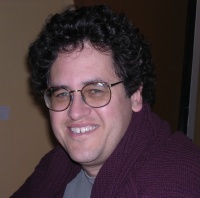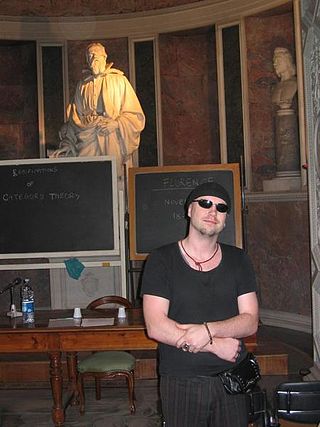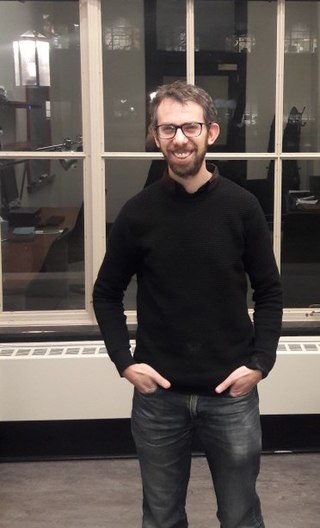Related Research Articles
In physics, the no-cloning theorem states that it is impossible to create an independent and identical copy of an arbitrary unknown quantum state, a statement which has profound implications in the field of quantum computing among others. The theorem is an evolution of the 1970 no-go theorem authored by James Park, in which he demonstrates that a non-disturbing measurement scheme which is both simple and perfect cannot exist. The aforementioned theorems do not preclude the state of one system becoming entangled with the state of another as cloning specifically refers to the creation of a separable state with identical factors. For example, one might use the controlled NOT gate and the Walsh–Hadamard gate to entangle two qubits without violating the no-cloning theorem as no well-defined state may be defined in terms of a subsystem of an entangled state. The no-cloning theorem concerns only pure states whereas the generalized statement regarding mixed states is known as the no-broadcast theorem.

John Carlos Baez is an American mathematical physicist and a professor of mathematics at the University of California, Riverside (UCR) in Riverside, California. He has worked on spin foams in loop quantum gravity, applications of higher categories to physics, and applied category theory. Additionally, Baez is known on the World Wide Web as the author of the crackpot index.
Noncommutative geometry (NCG) is a branch of mathematics concerned with a geometric approach to noncommutative algebras, and with the construction of spaces that are locally presented by noncommutative algebras of functions, possibly in some generalized sense. A noncommutative algebra is an associative algebra in which the multiplication is not commutative, that is, for which does not always equal ; or more generally an algebraic structure in which one of the principal binary operations is not commutative; one also allows additional structures, e.g. topology or norm, to be possibly carried by the noncommutative algebra of functions.

Samson Abramsky is Professor of Computer Science at University College London. He was previously the Christopher Strachey Professor of Computing at Wolfson College, Oxford, from 2000 to 2021.
String diagrams are a formal graphical language for representing morphisms in monoidal categories, or more generally 2-cells in 2-categories. They are a prominent tool in applied category theory. When interpreted in the monoidal category of vector spaces and linear maps with the tensor product, string diagrams are called tensor networks or Penrose graphical notation. This has led to the development of categorical quantum mechanics where the axioms of quantum theory are expressed in the language of monoidal categories.
In mathematics, higher category theory is the part of category theory at a higher order, which means that some equalities are replaced by explicit arrows in order to be able to explicitly study the structure behind those equalities. Higher category theory is often applied in algebraic topology, where one studies algebraic invariants of spaces, such as their fundamental weak ∞-groupoid.
In higher category theory, the concept of higher categorical structures, such as (∞-categories), allows for a more robust treatment of homotopy theory, enabling one to capture finer homotopical distinctions, such as differentiating two topological spaces that have the same fundamental group, but differ in their higher homotopy groups. This approach is particularly valuable when dealing with spaces with intricate topological features, such as the Eilenberg-MacLane space.
In category theory, a branch of mathematics, dagger compact categories first appeared in 1989 in the work of Sergio Doplicher and John E. Roberts on the reconstruction of compact topological groups from their category of finite-dimensional continuous unitary representations. They also appeared in the work of John Baez and James Dolan as an instance of semistrict k-tuply monoidal n-categories, which describe general topological quantum field theories, for n = 1 and k = 3. They are a fundamental structure in Samson Abramsky and Bob Coecke's categorical quantum mechanics.

André Joyal is a professor of mathematics at the Université du Québec à Montréal who works on category theory. He was a member of the School of Mathematics at the Institute for Advanced Study in 2013, where he was invited to join the Special Year on Univalent Foundations of Mathematics.
In mathematics, especially (higher) category theory, higher-dimensional algebra is the study of categorified structures. It has applications in nonabelian algebraic topology, and generalizes abstract algebra.
Categorical quantum mechanics is the study of quantum foundations and quantum information using paradigms from mathematics and computer science, notably monoidal category theory. The primitive objects of study are physical processes, and the different ways that these can be composed. It was pioneered in 2004 by Samson Abramsky and Bob Coecke. Categorical quantum mechanics is entry 18M40 in MSC2020.
Basil J. Hiley, is a British quantum physicist and professor emeritus of the University of London.

Bob Coecke is a Belgian theoretical physicist and logician who was professor of Quantum foundations, Logics and Structures at Oxford University until 2020, when he became Chief Scientist of Cambridge Quantum Computing, and after the merger with Honeywell Quantum Systems, Chief Scientist of Quantinuum. In January 2023 he also became Distinguished Visiting Research Chair at the Perimeter Institute for Theoretical Physics. He pioneered categorical quantum mechanics, Quantum Picturalism, ZX-calculus, DisCoCat model for natural language, and quantum natural language processing (QNLP). He is a founder of the Quantum Physics and Logic community and conference series, and of the applied category theory community, conference series, and diamond-open-access journal Compositionality.
Quantum contextuality is a feature of the phenomenology of quantum mechanics whereby measurements of quantum observables cannot simply be thought of as revealing pre-existing values. Any attempt to do so in a realistic hidden-variable theory leads to values that are dependent upon the choice of the other (compatible) observables which are simultaneously measured. More formally, the measurement result of a quantum observable is dependent upon which other commuting observables are within the same measurement set.
In mathematics, Solèr's theorem is a result concerning certain infinite-dimensional vector spaces. It states that any orthomodular form that has an infinite orthonormal set is a Hilbert space over the real numbers, complex numbers or quaternions. Originally proved by Maria Pia Solèr, the result is significant for quantum logic and the foundations of quantum mechanics. In particular, Solèr's theorem helps to fill a gap in the effort to use Gleason's theorem to rederive quantum mechanics from information-theoretic postulates. It is also an important step in the Heunen–Kornell axiomatisation of the category of Hilbert spaces.
Quantum foundations is a discipline of science that seeks to understand the most counter-intuitive aspects of quantum theory, reformulate it and even propose new generalizations thereof. Contrary to other physical theories, such as general relativity, the defining axioms of quantum theory are quite ad hoc, with no obvious physical intuition. While they lead to the right experimental predictions, they do not come with a mental picture of the world where they fit.
The ZX-calculus is a rigorous graphical language for reasoning about linear maps between qubits, which are represented as string diagrams called ZX-diagrams. A ZX-diagram consists of a set of generators called spiders that represent specific tensors. These are connected together to form a tensor network similar to Penrose graphical notation. Due to the symmetries of the spiders and the properties of the underlying category, topologically deforming a ZX-diagram does not affect the linear map it represents. In addition to the equalities between ZX-diagrams that are generated by topological deformations, the calculus also has a set of graphical rewrite rules for transforming diagrams into one another. The ZX-calculus is universal in the sense that any linear map between qubits can be represented as a diagram, and different sets of graphical rewrite rules are complete for different families of linear maps. ZX-diagrams can be seen as a generalisation of quantum circuit notation.

David Isaac Spivak is an American mathematician and senior scientist at the Topos Institute. He has worked on applications of category theory, in particular ologs and operadic compositionality of dynamical systems. He authored and coauthored the introductory texts on category theory and its applications, Category Theory for the Sciences and An Invitation to Applied Category Theory.
In mathematics, nonabelian algebraic topology studies an aspect of algebraic topology that involves higher-dimensional algebras.
DisCoCat is a mathematical framework for natural language processing which uses category theory to unify distributional semantics with the principle of compositionality. The grammatical derivations in a categorial grammar are interpreted as linear maps acting on the tensor product of word vectors to produce the meaning of a sentence or a piece of text. String diagrams are used to visualise information flow and reason about natural language semantics.
Quantum natural language processing (QNLP) is the application of quantum computing to natural language processing (NLP). It computes word embeddings as parameterised quantum circuits that can solve NLP tasks faster than any classical computer. It is inspired by categorical quantum mechanics and the DisCoCat framework, making use of string diagrams to translate from grammatical structure to quantum processes.
References
- ↑ "Applied Category Theory". MIT OpenCourseWare. Retrieved 2019-07-20.
- ↑ Spivak, David I.; Fong, Brendan (July 2019). An Invitation to Applied Category Theory by Brendan Fong. doi:10.1017/9781108668804. ISBN 9781108668804. S2CID 199139551.
- ↑ Bradley, Tai-Danae (2018-09-16). "What is Applied Category Theory?". arXiv: 1809.05923v2 [math.CT].
- ↑ Barr, Michael. (1990). Category theory for computing science. Wells, Charles. New York: Prentice Hall. ISBN 0131204866. OCLC 19126000.
- ↑ Ehrig, Hartmut; Große-Rhode, Martin; Wolter, Uwe (1998-03-01). "Applications of Category Theory to the Area of Algebraic Specification in Computer Science". Applied Categorical Structures. 6 (1): 1–35. doi:10.1023/A:1008688122154. ISSN 1572-9095. S2CID 290074.
- ↑ Abramsky, Samson; Coecke, Bob (2009), "Categorical Quantum Mechanics", Handbook of Quantum Logic and Quantum Structures, Elsevier, pp. 261–323, arXiv: 0808.1023 , doi:10.1016/b978-0-444-52869-8.50010-4, ISBN 9780444528698, S2CID 692816
- ↑ Duncan, Ross; Coecke, Bob (2011). "Interacting Quantum Observables: Categorical Algebra and Diagrammatics". New Journal of Physics. 13 (4): 043016. arXiv: 0906.4725 . Bibcode:2011NJPh...13d3016C. doi:10.1088/1367-2630/13/4/043016. S2CID 14259278.
- ↑ Coecke, Bob; Kissinger, Aleks (2017-03-16). Picturing quantum processes : a first course in quantum theory and diagrammatic reasoning. ISBN 978-1107104228. OCLC 1026174191.
- ↑ Heunen, Chris; Vicary, Jamie (2019-11-19). Categories for Quantum Theory: An Introduction. ISBN 9780198739616.
- ↑ Coecke, Bob; Sadrzadeh, Mehrnoosh; Clark, Stephen (2011), Mathematical Foundations for a Compositional Distributional Model of Meaning, arXiv: 1003.4394
- ↑ Kartsaklis, Dimitri; Sadrzadeh, Mehrnoosh; Pulman, Stephen; Coecke, Bob (2016), "Reasoning about meaning in natural language with compact closed categories and Frobenius algebras", Logic and Algebraic Structures in Quantum Computing, Cambridge University Press, pp. 199–222, arXiv: 1401.5980 , doi:10.1017/cbo9781139519687.011, ISBN 9781139519687, S2CID 8630039
- ↑ Grefenstette, Edward; Sadrzadeh, Mehrnoosh; Clark, Stephen; Coecke, Bob; Pulman, Stephen (2014), "Concrete Sentence Spaces for Compositional Distributional Models of Meaning", Text, Speech and Language Technology, Springer Netherlands, pp. 71–86, arXiv: 1101.0309 , doi:10.1007/978-94-007-7284-7_5, ISBN 9789400772830, S2CID 2411818
- ↑ Bonchi, Filippo; Sobocinski, Pawel; Zanasi, Fabio (2021), "A Survey of Compositional Signal Flow Theory", Advancing Research in Information and Communication Technology. IFIP Advances in Information and Communication Technology, Springer, doi:10.1007/978-3-030-81701-5_2
- ↑ Master, Jade; Baez, John C. (2018-08-16). "Open Petri Nets". arXiv: 1808.05415v4 [math.CT].
- ↑ Baez, John C.; Pollard, Blake S. (2018). "A compositional framework for reaction networks". Reviews in Mathematical Physics. 29 (9): 1750028–425. arXiv: 1704.02051 . Bibcode:2017RvMaP..2950028B. doi:10.1142/S0129055X17500283. ISSN 0129-055X. S2CID 119665423.
- ↑ "The n-Category Café". golem.ph.utexas.edu. Retrieved 2019-07-20.
